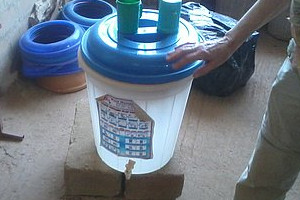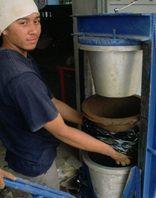Ceramic pot filter
| |
|
|
|
|
|
|
|
|
|
A ceramic pot filter consists of a flowerpot-shaped pot, made from a porous ceramic material. Water poured into a ceramic pot filter percolates through the pot material, and is collected in a second container.
There are many variations of the ceramic filter: some are made entirely from ceramics such as the Potters for Peace filters, some have a ceramic pot hanging in a plastic container such as Filter Pure (Agua Pure). Frequently, a colloidal silver coating is added to the ceramic filter. Some ceramic pot filters also include activated charcoal in the clay mixture to improve odour, taste, and colour.
Locally produced ceramics have been used to filter water for hundreds of years. Today, 150,000 filters are used in Central America, Asia and Africa.
CARE, UNICEF, Red Cross amongst others use the filter.
In Nicaragua, Guatemala and Cambodia the production of this filter is a commercial activity and production is starting up in six other countries.
Contents
Suitable conditions
The ceramic pot filter is suitable to process 8 litres of water per batch. This produces a daily water supply of 20-30 litres.
| Advantages | Disadvantages |
|---|---|
| - The filter is small and lightweight - Removes most pathogens and suspended solids |
- Low flow rate (1-3 litres per hour) - Set up is fragile, breaks easily, allowing bad water through undetectable cracks. |
|
|
Construction, operations and maintenance
Ceramic pot filters usually have a diameter of about 30 cm by 25 cm deep, with an 8 litre capacity. Two variations of ceramic filters, flat-bottom and round-bottom, are currently manufactured. The ceramic pot typically sits or hangs in the top of a larger plastic or ceramic container (20-30 litres), which is fitted with a tap at the bottom. A lid is placed on top of the filter to prevent contamination.
Ceramic pots are usually made from local clay mixed with a combustible material like sawdust, rice husks or coffee husks. The clay and combustible material are sieved through a fine mesh, and then mixed together with water until it forms a homogeneous mixture. The mixture is pressed into shape using a mold. When the pot is fired in a kiln, the combustible material burns out, leaving a network of fine pores through which the water can flow through.
Colloidal silver is sometimes applied to the ceramic pot after firing or added to the clay mixture prior to firing. Colloidal silver is an antibacterial which:
- Disables the enzyme that pathogenic bacteria and fungi use for oxygen metabolism, thus suffocating them.
- Destroys pathogens with an electric charge, causing their internal protoplast to collapse.
- Renders pathogens unable to reproduce.
- Kills parasites while in their egg stage.
Pathogens and suspended material are removed from water through a combination of biological and physical processes.
Quality control on the size of the combustible materials used in the clay mix ensures that the filter pore size is small enough to prevent contaminants from passing through the filter. Colloidal silver aids treatment by breaking down pathogens’ cell membranes, causing them to die.
Operation
Contaminated water is poured into the ceramic pot. The water slowly passes through the pores and is collected in the lower container. The treated water is stored in the container until needed, protecting it from recontamination. The user simple opens the tap at the base of the container when they need water.
For turbidity levels greater than 50 NTU, the water should first be strained through a cloth or sedimented before using the ceramic filter.
The estimated flow rate is 1-3 litres/hour. This is highest when the pot is full. It declines with use and accumulation of contaminants within the filter pores.
Manufacturing
Local production of the filters is common and preferable. A quality control process to ensure filter effectiveness is required. The lower container, lid and tap can usually be purchased locally.
Materials and facilities required are:
- Clay
- Combustible material (e.g. sawdust, rice husks, coffee husks)
- Colloidal silver (optional)
- Lid
- 20-30 litre ceramic or plastic container with tap
- A ceramic factory requires at least 100 m2 of covered area
- 15 to 20 ton hydraulic press (can be fabricated locally)
- Filter molds (can be fabricated locally)
- Mixer for clay and combustible material (can be fabricated locally)
- Hammer mill (can be fabricated locally)
- Kiln with an internal area of at least 1 cubic metre (can be fabricated locally)
- Racks
- Work benches
- Miscellaneous tools (e.g. traditional pottery tools)
A professional potter with experience in collecting clay, making ceramic articles, semi-industrial or mass production is required. Assistants, preferably potters are required. Skill and quality control in manufacturing is essential to ensure optimum pore size, flow rate and effectiveness.
Working with presses and kilns is potentially hazardous and adequate safety precautions should be used.
Treatment Efficiency
If properly constructed and operated, a ceramic filter can be very effective in producing good quality water. Ceramic filters with the silver coating have consistently tested to 99-100% removal of bacteria and parasites. These filters also eliminate the suspended sediments in the water, including any organic compounds that are adsorbed to the particles.
| Bacteria | Viruses | Protozoa | Helminths | Turbidity | Iron | {{{extra_Field}}} | |
|---|---|---|---|---|---|---|---|
| Laboratory | >98-100 % 12 | 19-99% 1 34 | Up to 100% 5 | up to 100% 5 | 83-99% 16 | not available | - |
| Field | 88 - >95.1% 27 | not available | Up to 100% 5 | Up to 100% 5 | <5 NTU 2 | >90% 6 | - |
Treatment efficiencies provided in the above table require colloidal silver. The treatment efficiency is also affected by pore size and construction quality. Taste, odour and colour of filtered water is generally improved.
Maintenance
It is recommended that the filter pot be replaced every 1-2 years. This is in part to protect against fine cracks which may have developed and are not be visible. Any cracks will reduce the effectiveness since water can short-circuit through the crack without being filtered through the ceramic pores.
There are no moving or mechanical parts to break in the ceramic pot filter. Small cracks can occur which are not visible to the naked eye, but which allow pathogens to pass through the filter. Poor transportation of filters can lead to cracking and/or breakage. Plastic taps in the lower container can break, metal taps last longer but increase cost.
A supply chain and market availability for replacement filters and taps is required. A quality control process is required to ensure filter effectiveness. Recontamination is possible during cleaning; care should be taken to use clean water, not to touch the ceramic with dirty hands, and not to place the filter on a dirty surface.
Continued use of the filter causes the pore openings in the ceramic to become clogged with debris. As a result, the flow rate of water through the filter decreases.
Filters are cleaned by lightly scrubbing the surface when the flow rate is reduced. Some manufacturers recommend to boil the filter every three months to ensure effectiveness. Some manufacturers recommend that soap and chlorine should not be used to clean the filter. The lower container, tap and lid should be cleaned on a regular basis.
Estimated Lifespan
The estimated lifespan of the filer element and the receptacle is up to 5 years. But generally it lasts for 1-2 years until partial replacement (exhausted/ broken filter element, broken plastic taps, or plastic bucket) is needed. Replacement is strictly needed when there are any visible holes that allows pathogens to enter.
Suppliers
Free press and kiln designs are available from Potters for Peace.
Costs
| Captial Cost | Operation Cost | Replacement Cost | Estimated 5 years Cost | Cost/liter treated |
|---|---|---|---|---|
| US$ 10-25 | US$ 0 | US$ 4 | US$ 18-31 | US$ ~0.001 |
Note: Program, transportation and education costs are not included.
Cost of introduction: US$ 15,000 - 30,000 for project incl. training, machinery and a first production of 500 filters. US$ 50,000 - 100,000 for project incl. production shop, training, first promotion, and 5,000 filters.
Field experiences
 Cost effective means of financing WASH |
Manuals, videos and links
Silver Lining - Part 1 |
Silver Lining - Part 2 |
- MANUAL: Use of Ceramic Water Filters in Cambodia. Water and Sanitation Program (WSP) and UNICEF.
- MANUAL: Michael Roberts. CERAMIC WATER PURIFIER CAMBODIA FIELD TESTS: IDE Working Paper No. 1. Practica Foundation. October 2003.
- MANUAL: Ceramic Water Filter Handbook. RDIC, February 2009.
- Joe Brown and Mark Sobsey. Independent Appraisal of Ceramic Water Filtration Interventions in Cambodia. UNC School of Public Health. May 2006.
- Doris van Halem, Ceramic silver impregnated pot filters for household drinking water treatment in developing countries. Delft University of Technology. Practica Foundation. November 2006.
- Thesis Dirk Jaap Stuurman, Msc. The Influence of Social Marketing on Adoption of Social Innovations: A Dyadic Study on Ceramic Pot Filters. Practica Foundation.
- Marketing first: Getting ceramic pot filters to the target group. Aqua For All and Practica Foundation. May 2010.
- RDIC (Resource Development International, Cambodia). Ceramic water filter information.
- Centers for Disease Control and Prevention. Some ceramic filter options.
- Filter Pure, Inc. FilterPure has developed a program based upon strategies of affordable water filtration, sustainable enterprise, and local education. The program has been designed to be replicated worldwide.
- Potters for Peace. Providing access to safe water with locally produced ceramic water filters.
- CeramicaTamakloe Limited. Materials supplier.
References
- ↑ 1.0 1.1 1.2 Lantagne (2001)
- ↑ 2.0 2.1 2.2 Smith (2004)
- ↑ Van Halem (2006)
- ↑ Some additives to the clay may increase virus removal.
- ↑ 5.0 5.1 5.2 5.3 Not researched, however helminths and protazoa are too large to pass between the 0.6-3 μm pores. Therefore, up to 100% removal efficiency can be assumed.
- ↑ 6.0 6.1 Low (2002)
- ↑ Brown and Sobsey (2006)
Acknowledgements
- Brown, J. and M. Sobsey (2006) Independent Appraisal of Ceramic Water Filtration Interventions in Cambodia: Final Report, Department of Environmental Sciences and Engineering, School of Public Health, University of North Carolina, USA.
- Lantagne, D. (2001) Investigation of the Potters for Peace Colloidal Silver Impregnated Ceramic Filter Report 2: Field Investigations. Alethia Environmental for USAID, USA. Also, Report 1, 2003.
- Low, J. (2002). Appropriate Microbial Indicator Tests for Drinking Water in Developing Countries and Assessment of Ceramic Water Filters, Master of Engineering thesis. Department of Civil and Environmental Engineering, Massachusetts Institute of Technology. Cambridge, Massachusetts, USA.
- Napotnik, J., Mayer, A., Lantagne, D. and K. Jellison Efficacy of Silver-Treated Ceramic Filters for Household Water Treatment. Department of Civil and Environmental Engineering, Lehigh University, USA.
- Smith, L. (2004) Ceramic Water Filter Use in Takeo, Cambodia – Operational Issues and Health Promotion Recommendations. Submitted in partial fulfilment as a requirement for a Master of Science in Control of Infectious Diseases, London School of Hygiene and Tropical Medicine, London, England.
- Van Halem, D. (2006) Ceramic silver impregnated pot filters for household drinking water treatment in developing countries. Masters of Science in Civil Engineering Thesis, Department of Water Resources, Delft University of Technology, Netherlands.
- Vinka, A. et al. (2007) Sustainable Colloidal-Silver-Impregnated Ceramic Filter for Point-of-Use Water Treatment, Environmental Science & Technology, Vol. 42, No. 3, 927–933




